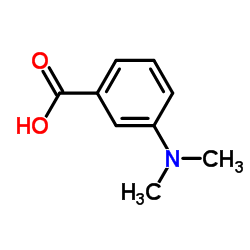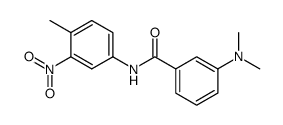208260-29-1
| Name | 3-(dimethylamino)-N-[3-[(4-hydroxybenzoyl)amino]-4-methylphenyl]benzamide |
|---|---|
| Synonyms |
3-(Dimethylamino)-N-[3-[(4-hydroxybenzoyl)amino]-4-methylphenyl]-benzamide
Benzamide (3-(dimethylamino)-N-[3-[(4-hydroxybenzoyl)amino]-4-methylphenyl] N-(5-(3-dimethylaminobenzamido)-2-methylphenyl)-4-hydroxybenzamide 3-(Dimethylamino)-N-{3-[(4-hydroxybenzoyl)amino]-4-methylphenyl}benzamide ZM 336372 |
| Description | ZM 336372 is a potent inhibitor of the protein kinase c-Raf. The IC50 value is 0.07 μM in the standard assay, which contains 0.1 mM ATP. |
|---|---|
| Related Catalog | |
| Target |
c-Raf:0.07 μM (IC50, 0.1 mM ATP) |
| In Vitro | ZM 336372 is a potent inhibitor of human c-Raf. The IC50 value is 0.07 μM in the standard assay, which contains 0.1 mM ATP. The IC50, decreases to 0.01μM at 0.025 mM ATP and increases to 0.9 μM at 2.5 mM ATP indicating that ZM 336372 is a competitive inhibitor with respect to ATP. ZM 336372 inhibits c-Raf tenfold more potently than B-Raf[1]. Cell proliferation analysis of ZM336372. 3,4-(4,5-Dimethylthiazol-2-yl)-2,5-diphenyltetrazolium bromide growth assay of H727 and BON treated as control, DMSO, and 100 μM ZM336372 to days 16 and 10, respectively. Both H727 and BON cell proliferation is inhibited in the presence of drug compared with controls. H727 cells treated with ZM336372 are growth suppressed, whereas control treatments have significantly more growth by day 6, continuing up to 16 days. A similar response is also seen in BON cells as growth suppression occurred as early as day 4 and was maintained out to day 10[2]. |
| Cell Assay | Proliferation of H727 and BON cells after treatment with ZM336372 is measured using a 3,4-(4,5-dimethylthiazol-2-yl)-2,5-diphenyltetrazolium bromide. Cells are trypsinized and plated in triplicate to 24-well plates and allowed to adhere overnight. Then, cells are treated with either 100 μM ZM336372 or DMSO (2%) and incubated. Media are changed every 2 days with new treatment. At each time point, cell growth rates are analyzed after the addition of 3,4-(4,5-dimethylthiazol-2-yl)-2,5-diphenyltetrazolium bromide reagent to the cultured cells. Absorbance is determined using spectrophotometer at a wavelength of 540 nm[2]. |
| References |
| Density | 1.3±0.1 g/cm3 |
|---|---|
| Boiling Point | 484.4±45.0 °C at 760 mmHg |
| Molecular Formula | C23H23N3O3 |
| Molecular Weight | 389.447 |
| Flash Point | 246.8±28.7 °C |
| Exact Mass | 389.173950 |
| PSA | 81.67000 |
| LogP | 3.98 |
| Appearance | white to beige |
| Vapour Pressure | 0.0±1.3 mmHg at 25°C |
| Index of Refraction | 1.704 |
| Storage condition | -20°C |
| Water Solubility | DMSO: >5mg/mL (warmed) |
| Hazard Codes | Xi |
|---|---|
| RIDADR | NONH for all modes of transport |
|
~% 
208260-29-1 |
| Literature: Bioorganic and Medicinal Chemistry Letters, , vol. 14, # 21 p. 5383 - 5387 |
|
~% 
208260-29-1 |
| Literature: Bioorganic and Medicinal Chemistry Letters, , vol. 14, # 21 p. 5383 - 5387 |
|
~% 
208260-29-1 |
| Literature: Bioorganic and Medicinal Chemistry Letters, , vol. 14, # 21 p. 5383 - 5387 |
|
~% 
208260-29-1 |
| Literature: Bioorganic and Medicinal Chemistry Letters, , vol. 14, # 21 p. 5383 - 5387 |
| Precursor 2 | |
|---|---|
| DownStream 0 | |



